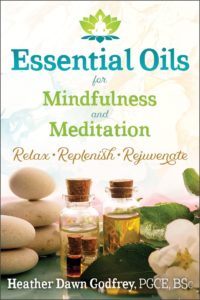Essential Oils for Mindfulness and Meditation: Relax, Replenish and Rejuvenate. / Heather Dawn Godfrey, 2018. Inner Traditions—Healing Arts Press. 146 pages, color illustrations, notes, index, bibliography.

I wanted to read this book because its title included the words essential oils for mindfulness and meditation. Such a title presumes not only information about essential oils and their application for the mind and emotions, but points to the deeper esoteric use of essential oils and meditation together, as other books from Healing Arts Press have. (For more on the evocative side of essential oils, please see Candice Covington’s Essential Oils in Spiritual Practice, reviewed here.)
The book’s author, Heather Dawn Godfrey, PGCE, BSc is a highly accomplished author and therapist. Currently in private practice, she provides therapy in the United Kingdom for physical well-being and mental outlook. Her website is at aromantique.co.uk. She is also a Fellow of the International Federation of Aromatherapists.
A handbook in size and tone, Essential Oils for Mindfulness and Meditation summarizes 3 areas: mindfulness, essential oils and their application, and complementary wellness. Seen as a lifestyle, the three would typify a healthy approach to body, mind, and spirit.
At the heart of the book, Godfrey discusses essential oils in all their practical aspects, how they affect the limbic structures of our brain, and their use, whether by inhalation or application to the body. Godfrey highlights the qualities of a group of 15 essential oils that offer the most calming benefits.
The author selected her set of oils to represent the psychological-emotional influence oils have on humans. She also advocates their use because among hundreds of essential oils, her list represents those that are the least irritating or those not known for causing discomfort or safety issues. She comments on a number of biological studies regarding the use of essential oils, substantiating their benefits.
Since we detect them by their scent, essential oils affect our senses first. We are aware of scent as a collection of “notes,” a word that denotes the relative position of scents to each other: top, middle, and base. In the list of 15, Lavender and Frankincense are examples of middle and base notes, respectively, while Cajeput and Galbanum are top notes. Top, middle, and base note information is worth knowing for effective blending, but also because essential oils are volatile—they evaporate easily, and at different rates.
A leading essential oil in terms of popularity is Lavender. From the graphic tables in the text, we see how Lavender (Lavandula angustifolia) affects the limbic structures of the brain which then impacts our endocrine and autonomic nervous systems. When you smell Lavender essential oil, you open up the possibility of relieving anger, depression, and grief, as well as other difficult situations you may encounter.
Emotions or reactions such as joy and fear, Godfrey says, are psychological responses which can be addressed with essential oils. This kind of detailed study of scents brings together the sciences of neurology, anatomy, biology and provides rationale for the use of essential oils when we are suffering emotional strain or psychological stress.
Another aspect of using essential oils is to apply them in specific ways for the results you want. Godfrey’s descriptions of containers and diffusers are helpful when deciding between simply inhaling a scent, rubbing it onto your wrists or temples, or selecting from the many types of diffusers available.
Finally, the author proposes that living a healthy life, with exercise, relaxation and a clean diet, is how you’ll create the conditions in your lifestyle that are conducive to optimal health.
Essential Oils for Mindfulness and Meditation is a package of information on living your life for optimal health because you need all parts of your being–body, mind, and spirit to function well. The author’s intent was for the pieces to work together, holistically, for this to occur. From her perspective it can be achieved by adopting her routines for body–complementary techniques; mind–the right essential oils; and spirit–mindfulness and meditation.
Essential Oils for Mindfulness and Meditation’s best parts are the ones which show distinctions between essential oils, how they are capable of providing relief from stress, and how they relate to our least understood body part, our brain. Most of all, the use of essential oils in the areas of emotion and psychology are clearly connected to science and may be taken seriously as a type of medicine for stress.



